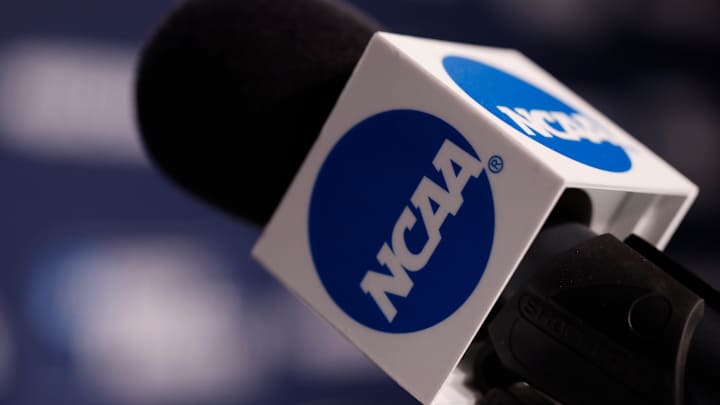NCAA DI Board of Directors Issues Guidance to NIL Collectives, Boosters

On Monday afternoon, the NCAA DI Board of Directors issued updated name, image and likeness guidance to schools, focusing primarily on cracking down on booster-led collectives aimed at making payments to college athletes.
The new guidelines clarify existing bylaws that are already in place that forbid boosters from being involved in the recruiting process, whether that involves persuading a high school athlete to attend an institution or an athlete in the transfer portal to attend the booster's program of choice. The guideline also establishes that the NCAA enforcement staff intends to investigate potential rules violations in the past, present and future.
The clarifying guidance comes 10 months after NIL first began to take place among college athletics. The NCAA enforcement staff is given the ability to investigate those who egregiously violated the established bylaws over the course of those 10 months, meaning that schools and/or collectives could retroactively face punishment.
Earlier on Monday, Southeastern Conference commissioner Greg Sankey met with reporters at the APSE Southeast Regional Meeting at the Alabama Sports Hall of Fame. During his interview session, Sankey commented at length about collectives and how they are impacting the landscape of NIL in college athletics.
“I’m equally certain there are those that are not reputable that don’t have disclosure policies, that don’t have boards that oversee their activity,” Sankey said.
Sankey is hopeful that, while it may be too late to punish rule-breakers who avoided guidelines that previously went unestablished, NIL legislation can still be put in place to limit the damage.
“Can we put the toothpaste back in the tube?" Sankey said. "The cow back in the barn? That’s part of those legislative conversations. Whether I’m optimistic or predict a federal solution or not, I am appreciative of the interest and the ability to work toward something that can support national competition in a healthy way across the college athletics spectrum.”
Here is the full release from the NCAA's updated NIL guidance:
DI Board of Directors issues name, image and likeness guidance to schools
Board supports continued opportunities for student-athletes
The Division I Board of Directors on Monday issued guidance to schools regarding the intersection between recruiting activities and the name, image and likeness environment.
Board members emphasized a continued support for the ability of student-athletes to benefit from their name, image and likeness. The guidance is intended to provide clarity for those engaging in a rapidly evolving NIL environment, acknowledging that the environment will continue to evolve, and ongoing attention will be needed to ensure student-athletes are able to benefit from these opportunities.
The guidance was developed by a task force of national leaders with student-athlete opportunity at the forefront of discussions. Specifically, the guidance defines as a booster any third-party entity that promotes an athletics program, assists with recruiting or assists with providing benefits to recruits, enrolled student-athletes or their family members. The definition could include "collectives" set up to funnel name, image and likeness deals to prospective student-athletes or enrolled student-athletes who might be considering transferring. NCAA recruiting rules preclude boosters from recruiting and/or providing benefits to prospective student-athletes.
The guidance is effective immediately. For violations that occurred prior to May 9, 2022, the board directed the enforcement staff to review the facts of individual cases but to pursue only those actions that clearly are contrary to the published interim policy, including the most severe violations of recruiting rules or payment for athletics performance. Schools are reminded of their obligation to report any potential violations through the traditional self-reporting process.
"Today, the Division I Board of Directors took a significant first step to address some of the challenges and improper behaviors that exist in the name, image and likeness environment that may violate our long-established recruiting rules. While the NCAA may pursue the most outrageous violations that were clearly contrary to the interim policy adopted last summer, our focus is on the future. The new guidance establishes a common set of expectations for the Division I institutions moving forward, and the board expects all Division I institutions to follow our recruiting rules and operate within these reasonable expectations," said board chair Jere Morehead, president, University of Georgia.
The board noted that the emphasis of this NIL guidance is on boosters in the recruiting process and is not intended to question the eligibility of prospective and enrolled student-athletes involved in NIL deals. Only the most serious actions that clearly violate the previously published interim policy would have eligibility implications.
The board adopted the interim guidance last summer with an understanding that they would consider further guidance as the name, image and likeness environment developed. This additional guidance is appropriate now as there is better understanding about the impact on student-athletes. Board members also urged schools to investigate, detect and self-report violations and cooperate with the NCAA enforcement staff as they investigate.
Board members acknowledged that more work must be done and asked the Division I Council to continue exploring additional measures to better ensure name, image and likeness opportunities align with NCAA values and protect the well-being of student-athletes.
Gallery: Alabama Athletes and NIL

Joey Blackwell is an award-winning journalist and assistant editor for BamaCentral and has covered the Crimson Tide since 2018. He primarily covers Alabama football, men's basketball and baseball, but also covers a wide variety of other sports. Joey earned his bachelor's degree in History from Birmingham-Southern College in 2014 before graduating summa cum laude from the University of Alabama in 2020 with a degree in News Media. He has also been featured in a variety of college football magazines, including Lindy's Sports and BamaTime.
Follow BlackwellSports